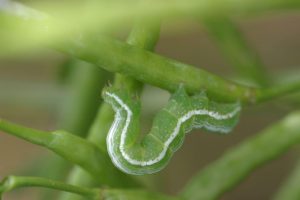
Cabbage looper at work.
Cabbage loopers are common pests which, as you might have guessed, are normally found on cabbage or cole crops. While in the larval stage, cabbage loopers will eat three times their body weight in plant material every day. This means that as they grow larger, the damage they do grows as well.
How to Identify Cabbage Loopers
You may know loopers better as inch worms. They are easy to recognize by their distinct form of movement in which they double up, or loop, their body as they move. They are generally one to one and a half inches long and have a pale green coloring with a white stripe along each side and several white lines down their back.
There are several types of insect larvae that might be called inch worms, such as those of garden webworms or diamond back moths, but telling them apart is not really necessary as they will all do the same type of damage and the same type of control methods should work as well.
How to Control Cabbage Loopers
Be vigilant – Keep a close eye on cabbage family plants. Be sure to look under leaves as well as on the outside of the plant. Larvae that you find can be easily drowned in a bit a soapy water. You should also brush off any eggs that you see.
Encourage predators – Plants such as parsley, coriander, dill, fennel and sweet alyssum will attract birds and other insects that will feed on the larvae.
Pheromone traps – These traps will attract the adult moths. In addition to trapping some of the adults before they can lay eggs, you can use them to identify when the moths are in the area so that you’ll know when you need to be especially watchful for the larvae.
Floating row covers – These covers can keep the adult moths from reaching plants to lay eggs. They can make a big difference if their use is timed correctly with signals from traps.
Wasps – Wasps are one of the most effective enemies against cabbage loopers. They will destroy larvae as well as eggs. Trichogramma wasps work especially well and can be purchased online or in garden centers. Simply release them in the garden and let them go to work.
BTK Sprays – These sprays contain a natural soil bacteria called Bacillus Thuringiensis or Bt-kurstaki. You can safely spray directly on the larvae and on plants for prevention. These sprays do not harm bees or birds and are safe for pets and children too.
Spinosad – This is another biological solution that is derived from the process of fermentation. It is the main ingredient in Monterey Garden Insect Spray, which has been classified as organic by the USDA and listed for organic use by the Organic Materials Review Institute.
Bury spent crops – After you’ve harvested from your plants, bury any remains well. This will destroy any leftover eggs and cocoons, preventing new adults from emerging in the spring.
Botanical insecticides – As a last resort, you can try other botanical insecticides, but be sure that you read labels carefully and have verified that they are safe to use on plants that you will consume.
A Combined Effort
As with most insect problems, your best defense is going to be a combination of several of the suggestions listed above. You may find some easier to implement than others. Choose what will work best for you. The most important thing to remember is just that you have to keep a close eye on your plants and step up your efforts if you think the cabbage looper population is growing. These tiny insects can do amazing amounts of damage if they are not controlled once they’ve been spotted.

No Comments